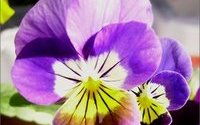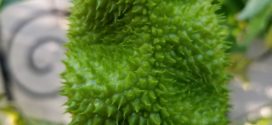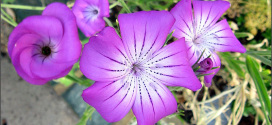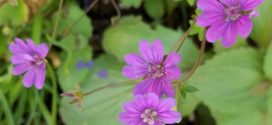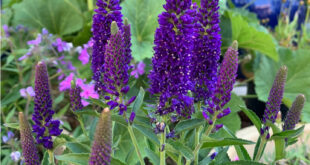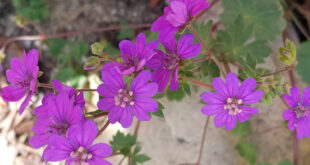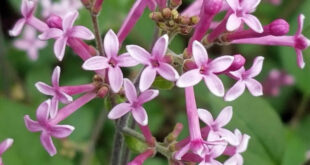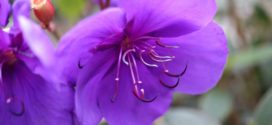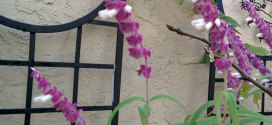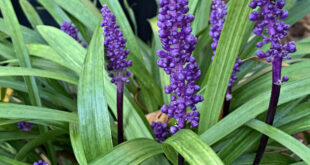Pansies have colors and bicolors including yellow, gold, orange, purple, violet, red, white, and even near-black (very dark purple). Pansies typically display large showy face markings. Plants grow well in sunny or partially sunny positions in well-draining soils. Pansies are perennial, but normally grown as biennials or annuals because of their leggy growth. The first year plant produces greenery, and …
Read More »Tag Archives: purple
Purple Trumpet Vine Pod
As I was searching for ripe tomatoes among the tomato plants, I discovered this large strange pod. It is the pod for Purple Trumpet Vine. I have grown this vine for 15 years but have never noticed the pod. The example for the oversight is that it appears during peak tomato season and the vine is obscured by the full …
Read More »Corncockle
Corncockle is a pretty flower that bobs in the wind on slender stalks. Warning: Probably should not be planted around small children. All parts of the plant are toxic to eat. But then again, so are many other common plants such as daffodils and foxgloves. I still recommend it for Sunnyvale gardens. The Corncockle originated in Europe where it grew …
Read More »Geranium pyrenaicum ‘Bill Wallis’
Dozens of deep purple-blue blossoms in a small package (15″ tall x 20″). Reliably perennial, it happily self-sows to fill in bare spots with its ever-present color. When the flowers are spent (after months), cut back to 1”, side dress with compost & it’ll burst right back into bloom. BEST in rich soil & half day sun, but not required. …
Read More »Veronica
A blast of dense, vertical spikes that bloom for months in our mild climate – & then blooms again! Veronica longfolia “Vernique” is a hybrid version of this essential cottage perennial. It rises to 2 feet tall and 2 feet wide across bearing rich, purple, 6” spikes from late Spring to July, attracting mobs of butterflies, bees & hummers! Cut …
Read More »Phlox
Phlox subulata is a short plant, and its stature is reflected in its common names: “creeping phlox,” “moss phlox,” “moss pinks,” “ground pink,” and “ground phlox.” Don’t let the “pink” label fool you: This perennial does come in other colors. Not surprisingly, Phlox subulata functions primarily as a flowering ground cover. You’ll often see this spring bloomer blanketing banks with …
Read More »Bloomerang Lilac
Bloomerang Purple lilac (Syringa x) is a reblooming lilac. It blooms in spring along with other lilacs, takes a brief rest to put on new growth, then blooms again from mid-summer through fall. A bit smaller than other lilacs, Bloomerang also has a nice, rounded shape that looks great anywhere you plant it in the landscape. Star-like flowers are a …
Read More »Princess Flower
Tibouchina urvilleana: A beautiful, tropical look from an evergreen shrub with huge, exotic, deep-purple flowers that will bloom throughout summer. Its upright, open-branched habit is useful as a hedge, screen or accent. Zones 10-11: Protect from frost Light Needs: Partial to full sun Watering Needs: Water regularly – weekly, or more often in extreme heat or containers. Size: Up to …
Read More »Salvia leucanthus – Mexican bush sage
Mexican bush sage (Salvia leucantha) is a beautiful, hardy plant for Alta California. This downy, bushy, evergreen subshrub produces white or purple flowers clasped by soft purple calyces from late summer to frost. It grows 3 feet tall by 3 feet wide, and is great for the border. Salvias are some of the showiest plants for containers, annual borders, and …
Read More »Lilyturf
Lilyturf (Liriope muscari) is a tough but showy evergreen groundcover has deep green, grass-like foliage arranged in slightly upright tufts. Spikes of blue or purple (see below) bell-shaped flowers resembling grape hyacinth (hence its species name) appear in summer, followed by dark berry-like fruits. Great for edging pathways or as and a low border accent. Grows well underneath trees or …
Read More »